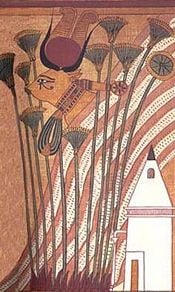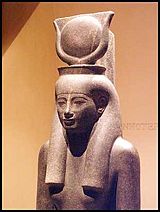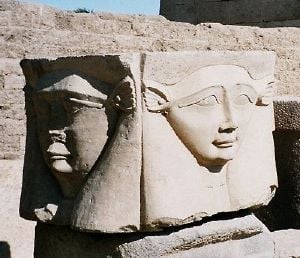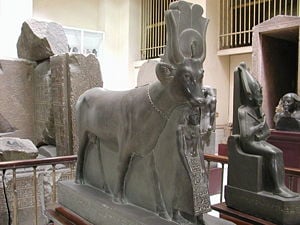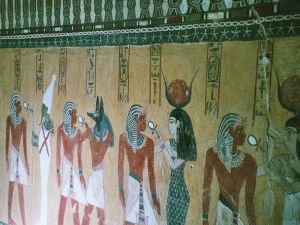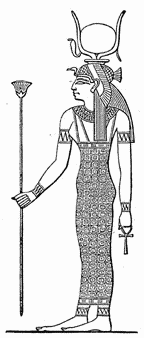Hathor
In Egyptian mythology, Hathor (Egyptian for "House of Horus") was an ancient cow goddess whose wide range of attributes and associations are testament to her tremendous antiquity. She was affiliated with sexuality, fertility, and joy, but was also seen as a goddess of the sky, as evidenced by the etymological connection between herself and Horus (a sky god). Further, she was also symbolically connected with the Milky Way, which was seen as the milk that flowed from her divine udder.[1] In this celestial context, she was occasionally characterized as an Eye of Ra, an aggressive and violent role that is most potently represented in the story of her violent assault upon a human race that failed to sufficiently honor her father (as described below). Finally, she also figured into the mythological understanding of the afterlife, where she was understood to provide peace and solace to the souls of the deceased.
In keeping with the goddess's tremendous antiquity and geographical ubiquity, the cult of Hathor was one of the most prominent in the Ancient Egyptian world. This prevalence led to an extensive network of temples spanning the entire Egyptian kingdom, coupled with a flourishing popular cult—both of which are attested to by archaeological evidence.
Hathor in an Egyptian Context
As an Egyptian deity, Hathor belonged to a religious, mythological and cosmological belief system that developed in the Nile river basin from earliest prehistory to around 525 B.C.E. This particular "cut-off" date has been chosen because it corresponds to the Persian conquest of the kingdom, which marks the end of its existence as a discrete and (relatively) circumscribed cultural sphere. Indeed, as this period also saw an influx of immigrants from Greece, it was also at this point that the Hellenization of Egyptian religion began. While some scholars suggest that even when "these beliefs became remodeled by contact with Greece, in essentials they remained what they had always been" [2]it still seems reasonable to address these traditions, as far as is possible, within their own cultural milieu. Indeed, it was during this relatively late period in Egyptian cultural development, a time when they first felt their beliefs threatened by foreigners, that many of their myths, legends and religious beliefs were first recorded. The numerous inscriptions, stelae and papyri that resulted from this sudden stress on historical posterity provide much of the evidence used by modern archaeologists and Egyptologists to approach the ancient Egyptian tradition [3] The cults were generally fairly localized phenomena, with different deities having the place of honor in different communities.These local groupings often contained a particular number of deities and were often constructed around the incontestably primary character of a creator god [4] Yet, the Egyptian gods (unlike those in many other pantheons) were relatively ill-defined. As Frankfort notes, “If we compare two of [the Egyptian gods] … we find, not two personages, but two sets of functions and emblems. … The hymns and prayers addressed to these gods differ only in the epithets and attributes used. There is no hint that the hymns were addressed to individuals differing in character.”[5] One reason for this was the undeniable fact that the Egyptian gods were seen as utterly immanent—they represented (and were continuous with) particular, discrete elements of the natural world.[6] [7] Thus, those Egyptian gods who did develop characters and mythologies were generally quite portable, as they could retain their discrete forms without interfering with the various cults already in practice elsewhere. Furthermore, this flexibility was what permitted the development of multipartite cults (i.e. the cult of Amun-Re, which unified the domains of Amun and Re), as the spheres of influence of these various deities were often complimentary.[8]
The worldview engendered by ancient Egyptian religion was uniquely defined by the geographical and calendrical realities of its believers' lives. The Egyptians viewed both history and cosmology as being well ordered, cyclical and dependable. As a result, all changes were interpreted as either inconsequential deviations from the cosmic plan or cyclical transformations required by it.[9] ;[10]; Breasted argues that one source of this cyclical timeline was the dependable yearly fluctuations of the Nile [11] The major result of this perspective, in terms of the religious imagination, was to reduce the relevance of the present, as the entirety of history (when conceived of cyclically) was defined during the creation of the cosmos. The only other aporia in such an understanding is death, which seems to present a radical break with continuity. To maintain the integrity of this worldview, an intricate system of practices and beliefs (including the extensive mythic geographies of the afterlife, texts providing moral guidance (for this life and the next) and rituals designed to facilitate the transportation into the afterlife) was developed, whose primary purpose was to emphasize the unending continuation of existence.[12]; [13] Given these two cultural foci—the creation of the cosmos, and death—it is understandable that the tales recorded within this mythological corpus tended to be either creation accounts or depictions of the world of the dead, with a particular focus on the relationship between the gods and their human constituents.
Mythological Accounts
As noted above, Hathor was a goddess whose tremendous antiquity led to an innumerable variety of mythological and cultic roles. This fact greatly problematizes any attempt to summarize her classical characterizations, especially when one notes that she often subsumed local goddess cults and adopted their roles as well. It is for this reason that Budge argues that each major city likely had its own unique cult of Hathor,[14] a fact that necessitates the limitation of the following sketch to her most prevalent accounts and characterizations. This proviso is made following Wilkinson [15]
Goddess of motherhood, sexuality and joy
Most prominently, Hathor can be seen as an instance of the Great Goddess archetype, due to her association with fertility and sexuality. Specifically, she was often seen as the personification of the joyful, life-affirming component of sexual intercourse—a characterization that is echoed in many of the mythic accounts describing her. For instance, in the early Enneadic cosmogony, where Atum creates the universe through his divine onanism, this act is often described as a union of two gendered principles, with Atum as the male power (the divine phallus) and Hathor as the "hand of Atum."[16] Even more explicitly, the Contendings of Horus and Seth contains the following salacious tale:
- the sun god Pre (Ra) becomes angry when he is insulted by the baboon god Babi and lies down on his back. This implies that the creator sun god was sinking back into the inert state that would mean the end of the world. Hathor, Lady of the Southern Sycamore, visits her father Pre and shows him her genitals. He immediately laughs, gets up, and goes back to administering maat (justice). Hathor has aroused the sun god and driven away his evil mood.[17]
In these various sexual capacities, Hathor was seen as a goddess of joy, which explains the extent to which she was revered by the general populace. She was most particularly adored by women, who aspired to embody her multifaceted role as wife, mother, and lover. In this regard, she gained many mythological and cultic titles, including "Lady of the House of Jubilation," "The One Who Fills the Sanctuary with Joy," and "Mistress of the Vagina."[18] This characterization came to be so widespread that she was (at times) seen as the mother of all youthful gods (including Nefertem, Ify, Harsomatus,[19] and, most significantly, Horus[20]).
Hathor's general association with sexuality and joy meant that many of her religious festivals were ecstatic, frenzied affairs. As a result, she also became acknowledged as the divine patron of music. In particular, she was equated with the sistrum (an ancient percussion instrument) and the menat (a musical necklace made of turquoise), both of which were likely used in the ritual dances that were performed in her honor. This role is exemplified in a hymn to the goddess, which states:
- Thou art the Mistress of Jubilation, the Queen of the Dance, the Mistress of Music, the Queen of the Harp Playing, the Lady of the Choral Dance, the Queen of Wreath Weaving, the Mistress of Inebriety Without End.[21]
This final reference to drunkenness is intriguing, as it contains a mythological link to Hathor's bloodthirsty persona (described below), whose ravages could only be stemmed by tricking her into consuming thousands of liters of beer.
Sky Goddess
Hathor's initial role as a celestial deity is evidenced by the etymology of her name (Het-Heru, "House of Horus"), which indicates that she was "a personification of the house in which Horus the Sun-god dwelt, and that she represented the portion of the sky through which the course of the god lay."[22] Despite this initially constrained domain, Budge postulates that she eventually came to be associated with the sky as a whole, which allowed her to absorb "many of the attributes of [other] predynastic goddesses."[23] Conversely, she was also often associated with the night sky, in particular with the Milky Way galaxy.[24]
Iconographically, Hathor, who was often depicted in bovine form, is typically represented bearing the solar disk atop her head.
Wife of Thoth
When Horus became identified as Ra (Ra-Herakhty) in the evolving Egyptian pantheon, Hathor's position became unclear, since in later myths she had been the wife of Ra, but in earlier myths she was the mother of Horus. One attempt to solve this conundrum gave Ra-Herakhty a new wife, Ausaas, which meant that Hathor could still be identified as the mother of the new sun god. However, this left open the unsolved question of how Hathor could be his mother, since this would imply that Ra-Herakhty was a child of Hathor, rather than a creator. Such inconsistencies developed as the Egyptian pantheon changed over the thousands of years becoming very complex, and some were never resolved.
In areas where the cult of Thoth became strong, Thoth was identified as the creator, leading to it being said that Thoth was the father of Ra-Herakhty, thus in this version Hathor, as the mother of Ra-Herakhty, was referred to as Thoth's wife. In this version of what is called the Ogdoad cosmogony, Ra-Herakhty was depicted as a young child, often referred to as Neferhor. When considered the wife of Thoth, Hathor often was depicted as a woman nursing her child. Arising from this syncretism, the goddess Seshat, who had earlier been thought of as Thoth's wife, came to be identified with Hathor. For instance, the cow goddess came to be associated with the judgment of souls in Duat, which led to the title 'Nechmetawaj ("the (one who) expels evil"). By a homophonic coincidence, Nechmetawaj (which can also be spelled Nehmet-awai and Nehmetawy) can also be understood to mean (one who) recovers stolen goods, which resultantly came to be another of the goddess's traits.
Outside the cult of Thoth, it was considered important to retain the position of Ra-Herakhty (i.e. Ra) as self-created (via only the primal forces of the Ogdoad). Consequently, Hathor could not be identified as Ra-Herakhty's mother. Hathor's role in the process of death, that of welcoming the newly dead with food and drink, led, in such circumstances, to her being identified as a jolly wife for Nehebkau, the guardian of the entrance to the underworld and binder of the Ka. Nevertheless, in this form, she retained the name of Nechmetawaj, since her aspect as a returner of stolen goods was so important to society that it was retained as one of her roles.
Goddess of the Dead
Given her ubiquity in classical sources, it is not surprising that Hathor also played an important role in the extensive Egyptian myths surrounding the afterlife. Specifically, she was thought to provide hope, sustenance and succor to the souls of the dead:
- From quite early times, especially in the Memphite region, she was worshiped as a tree goddess, 'mistress of the sycamore' who supplied food and drink to the deceased; and from at least the eighteenth dynasty she served as the patron deity of the Theban necropolis, where she protected and nurtured royalty and commoners alike, either in the form of a cow or as the anthropomorphic 'mistress of the west' who was often depicted welcoming the deceased to the afterlife with purifying and refreshing water. She was considered to receive the dying sun each evening and so it was a desire of the deceased to be 'in the following of Hathor.'[25]
Bloodthirsty Warrior
The Middle Kingdom was founded when Upper Egypt's pharaoh, Mentuhotep II, forcibly took control of Lower Egypt, which had become independent during the First Intermediate Period. The unification that had been achieved through this brutal war allowed the reign of the next pharaoh, Mentuhotep III, to be peaceful. From this foundation, Egypt once again became prosperous. During this period, the Lower Egyptians penned a memorial tale commemorating those who fell in the protracted battle, enshrining their own experience during the protracted civil war.
In this allegorical tale, Ra (representing the pharaoh of Upper Egypt) was no longer respected by the people of Lower Egypt, who had ceased to obey his authority. The god was so aggrieved that he sent out Sekhmet (war goddess of Upper Egypt) to destroy them. Following these orders, the goddess began to slaughter every being in her path in a bloodthirsty rage. As she continued to cut a swathe through the mortal coil, the gods began to fear that all of humanity would be destroyed, and, as the destruction was his responsibility, Ra was charged with stopping her. The crafty god proceeded to pour blood-red dye into a huge quantity of beer, which he then poured on the ground. In her unstoppable bloodlust, Sekhmet found herself compelled to drink it all, after which point she became too drunk to continue the carnage. Humanity was saved. When she awoke from her besotted slumber, Sekhmet transformed into a loving and kind goddess.
The gentle form that Sekhmet had become by the end of the tale was identical in character to Hathor, and so a new cult arose, at the start of the Middle Kingdom, which dualistically identified Sekhmet with Hathor, making them one goddess, Sekhmet-Hathor, with two sides. Consequently, Hathor, as Sekhmet-Hathor, was sometimes depicted as a lioness. Sometimes this joint name was corrupted to Sekhathor (also spelled Sechat-Hor, Sekhat-Heru), meaning (one who) remembers Horus (the uncorrupted form would mean (the) powerful house of Horus but Ra had displaced Horus, thus the change).
However, this new identification was neither tremendously popular nor widespread, likely due to the diametrical opposition between the characters of the two goddesses.[26]
Cultic Observances
The cult of Hathor was one of the most venerable and wide-spread in ancient Egypt. Whether one accepts the popular attribution of a pre-dynastic standard to the goddess, it remains the case that verifiable evidence to her worship can be traced back to the first or second dynasty (ca. 3,000 B.C.E.). Further, and in a marked contrast to many of the other gods in the Egyptian pantheon, the cult of Hathor was not tied to a particular geographic locality and was instead diffused throughout the nation. As Wilkinson notes, "the worship of Hathor was so widespread that she was often regarded as a form of the indigenous deity in localities where she originally had no cult of her own. In this way, at Thebes Hathor was identified with Mut, and at Elephantine with Sothis. Despite the fact that by the end of Egypt's history Hathor was often assimilated with the goddess Isis, there remain many instances where the ancient deity still maintained her identity and continued to be venerated by the Egyptians with great affection."[27]
In her prolific temple cult, which was practiced in such varied locales as Atfih, Cusae, Memphis, Thebes, Deir el-Medina, and Dendera,[28] the goddess's male and female priests enacted many ritual proceedings—most notably a "divine marriage" festival (commemorating the union of Hathor and Horus) that was joyfully celebrated by "royalty, nobles and commoners alike."[29] In addition to her highly developed temple cult, she was also the recipient of considerable public veneration, as attested to by a multitude of archaeological relics (including jewelry, mirrors, and votive offerings) bearing her image.[30] Her myriad associations, from protecting women in childbirth to succoring the souls of the deceased, were likely responsible for this abundance of representations, as Pinch notes in her article on the Deir el Bahari excavation:
- The Deir el Bahari offerings make it clear that the ancient Egyptians had faith in Hathor to protect them in life and in death. They sought personal contact with her and brought their daily problems to her, as well as seeking more general blessings. In life she was associated with sexuality and birth, and thereby equally important to the peasant and the great official. In her role as conductress of souls into the Afterlife she softened the fear of death and gave hope of rebirth. All this is reflected in the variety of objects presented to her.[31]
Hathor outside Egypt
Hathor was worshipped in Canaan in the eleventh century B.C.E. at the holy city of Hazor (Tel Hazor), which at that time was ruled by Egypt. Early stone inscriptions seem to suggest that the Hebrew workers in the mines of Sinai (ca. 1500 B.C.E.) worshiped Hathor, who they identified with their goddess Astarte. Based on this fact, some theories imply that the golden calf mentioned in the Bible was an image of the goddess (Exodus 32:4-6). This hypothesis has been lent considerable weight by various archaeological excavations that have revealed ancient mining camps and their associated Temples of Hathor, the first of which was led by the famed Egyptologist Sir Flinders Petrie. One such structure was constructed by Seti II at the copper mines at Timna in Edomite Seir.[32]
The Greeks, who became rulers of Egypt for three hundred years before the Roman domination in 31 B.C.E., also loved Hathor and equated her with their own goddess of love and beauty, Aphrodite.[33]
Notes
- ↑ An alternate name for Hathor, which persisted for 3,000 years, was Mehturt (also spelled Mehurt, Mehet-Weret, and Mehet-uret), meaning great flood, a direct reference to her being the Milky Way. Geraldine Pinch. Handbook of Egyptian mythology. (Santa Barbara, CA: ABC-CLIO, 2002), 163.
- ↑ Adolf Erman. A handbook of Egyptian religion, translated by A. S. Griffith. (London: Archibald Constable, 1907), 203
- ↑ Pinch, 31-32.
- ↑ Dimitri Meeks and Christine Meeks-Favard. Daily life of the Egyptian gods, Translated from the French by G. M. Goshgarian. (Ithaca, NY: Cornell University Press, 1996), 34-37
- ↑ Henri Frankfort, Ancient Egyptian Religion. (New York: Harper Torchbooks, 1961), 25-26.
- ↑ Christiane Zivie-Coche. Gods and men in Egypt: 3000 B.C.E. to 395 C.E., Chapter 1 Pharaonic Egypt, translated from the French by David Lorton. (Ithaca, NY: Cornell University Press, 2004), 40-41
- ↑ Frankfort, 23.
- ↑ Ibid., 20-21.
- ↑ Jan Assmann. In search for God in ancient Egypt, translated by David Lorton. (Ithaca, NY: Cornell University Press, 2001), 73-80
- ↑ Zivie-Coche, 65-67
- ↑ James Henry Breasted. Development of religion and thought in ancient Egypt. (Philadelphia: University of Pennsylvania Press, 1986), 8, 22-24.
- ↑ Frankfort, 117-124
- ↑ Zivie-Coche, 154-166.
- ↑ E. A. Wallis Budge. The gods of the Egyptians; or, Studies in Egyptian mythology. A Study in Two Volumes. (New York: Dover Publications, 1969, Vol. I), 434.
- ↑ Richard H. Wilkinson. The Complete Gods and Goddesses of Ancient Egypt. (London: Thames and Hudson, 2003), 140.
- ↑ Pinch, 138.
- ↑ Ibid.
- ↑ Wilkinson, 141-143.
- ↑ Pinch, 137.
- ↑ Wilkinson, 140.
- ↑ C. J. Bleeker and G. Widengren, Historia Religionum: Handbook for the History of Religions - Religions of the Past. (Leiden: Brill, 1997), 1. Quoted on piney.com
- ↑ Budge, Vol. I, 428.
- ↑ Ibid., 428-429.
- ↑ Wilkinson, 140.
- ↑ Wilkinson, 143. See also: Budge (1969), Vol. I, 435-437. Also, the Egyptian Book of the Dead THE BOOK OF THE DEAD The Papyrus of Ani Plate (XXVII) describes her in her characterization as a tree goddess.Retrieved November 13, 2007.
- ↑ Wilkinson, 140; Pinch (2002), 74-75, 138. See also: [www.sacred-texts.com/egy/leg/leg05.htm sacred-texts.com] for another version of the tale.
- ↑ Wilkinson, 145.
- ↑ Wilkinson, 144. Budge (1969) goes so far as to suggest that "if we had full information on the subject we should probably find that each great city possessed its own selection of Hathors, and that the forms of the goddess whose names were inscribed on funeral papyri were only those which were popular with those who caused such documents to be made" (Budge, Vol. I, 434).
- ↑ Wilkinson, 145. The mixed genders of the members of the Hathorian priesthood (and the question of whether these roles were hereditary) is explored in Marianne Galvin's "The Hereditary Status of the Titles of the Cult of Hathor," The Journal of Egyptian Archaeology, 70 (1984): 42-49.
- ↑ Pinch (1982), passim. See also: Wilkinson, 145.
- ↑ Pinch (1982), 148.
- ↑ See A. Barrois, "The Serabit Expedition of 1930: The Mines of Sinai," The Harvard Theological Review 25(2) (April 1932): 101-121; Herbert G. May, "Moses and the Sinai Inscriptions." The Biblical Archaeologist 8(4) (December 1945): 93-99.
- ↑ Harold Bell, "Popular Religion in Graeco-Roman Egypt: I. The Pagan Period." The Journal of Egyptian Archaeology 34 (December 1948): 82-97, 84. See also: Budge (1969), Vol I, 435.
ReferencesISBN links support NWE through referral fees
- Assmann, Jan. In search for God in ancient Egypt, translated by David Lorton. Ithaca, NY: Cornell University Press, 2001. ISBN 0801487293.
- Balter, Michael. The Goddess and the Bull – Catalhöyük: An Archaeological Journey to the Dawn of Civilization. New York: Simon & Schuster, 2005. Free Press, 2004. ISBN 9780743243605
- Barrois, A. "The Serabit Expedition of 1930: The Mines of Sinai." The Harvard Theological Review 25(2) (April 1932): 101-121.
- Breasted, James Henry. Development of religion and thought in ancient Egypt. Philadelphia: University of Pennsylvania Press, 1986. ISBN 0812210454
- __________. Development of Religion and Thought in Ancient Egypt (Lectures delivered on the Morse Foundation at Union Theological Seminary) Adamant Media Corporation, 2005. ISBN 9781402141294
- Budge, E. A. Wallis (translator). The Egyptian Book of the Dead. 1895. Accessed at sacred-texts.com.
- __________. (translator). Egyptian Book of the Dead: The Papyrus of Ani. Black Dog & Leventhal Publishers, 2006. ISBN 9781579124915 (original 1895)
- __________. The Egyptian Heaven and Hell. 1905. Accessed at [www.sacred-texts.com/egy/ehh.htm sacred-texts.com].
- __________. The gods of the Egyptians; or, Studies in Egyptian mythology. A Study in Two Volumes. New York: Dover Publications, 1969.
- __________. Legends of the Gods: The Egyptian texts. 1912. Accessed at sacred-texts.com.
- ___________. The Rosetta Stone. (1893), 1905. Accessed at sacred-texts.com.
- Dunand, Françoise and Christiane Zivie-Coche. Gods and men in Egypt: 3000 B.C.E. to 395 C.E. translated from the French by David Lorton. Ithaca, NY: Cornell University Press, 2004. ISBN 080144165X
- Erman, Adolf. A handbook of Egyptian religion, translated by A. S. Griffith. London: Archibald Constable, 1907.
- Frankfort, Henri. Ancient Egyptian Religion. New York: Harper Torchbooks, 1961. ISBN 0061300772
- Frankfort, Henri. Ancient Egyptian Religion: An Interpretation. Dover Publications, 2000. (original 1961) ISBN 9780486411385.
- Galvin, Marianne. "The Hereditary Status of the Titles of the Cult of Hathor," The Journal of Egyptian Archaeology 70 (1984).
- Griffith, F. L. and Herbert Thompson, (translators). The Leyden Papyrus. 1904. Accessed at sacred-texts.com.
- May, Herbert G. "Moses and the Sinai Inscriptions." The Biblical Archaeologist 8(4) (December 1945).
- Meeks, Dimitri and Christine Meeks-Favard. Daily life of the Egyptian gods. Translated from the French by G. M. Goshgarian. Ithaca, NY: Cornell University Press, 1996. ISBN 0801431158
- Mercer, Samuel A. B. (translator). The Pyramid Texts. 1952. Accessed online at [www.sacred-texts.com/egy/pyt/index.htm sacred-texts.com].
- Pinch, Geraldine. Handbook of Egyptian mythology. Santa Barbara, CA: ABC-CLIO, 2002. ISBN 1576072428
- Pinch, Geraldine. "Offerings to Hathor." Folklore 93(2) (1982), 138-150.
- Shafer, Byron E. (editor) Temples of ancient Egypt. Ithaca, NY: Cornell University Press, 1997. ISBN 0801433991
- Wilkinson, Richard H. The Complete Gods and Goddesses of Ancient Egypt. London: Thames and Hudson, 2003. ISBN 0500051208
Credits
New World Encyclopedia writers and editors rewrote and completed the Wikipedia article in accordance with New World Encyclopedia standards. This article abides by terms of the Creative Commons CC-by-sa 3.0 License (CC-by-sa), which may be used and disseminated with proper attribution. Credit is due under the terms of this license that can reference both the New World Encyclopedia contributors and the selfless volunteer contributors of the Wikimedia Foundation. To cite this article click here for a list of acceptable citing formats.The history of earlier contributions by wikipedians is accessible to researchers here:
The history of this article since it was imported to New World Encyclopedia:
Note: Some restrictions may apply to use of individual images which are separately licensed.
